The Day After Tomorrow
I liked the film The Day After Tomorrow. It was about catastrophic climate change.t
I seem to remember that most reviews panned some of the science, saying that some eminent scientists said such climate changes could not happen so quickly.
A random example,
http://www.smh.com.au/articles/2004/05/28/1085641700583.html
... Some eminent climatologists have said the science is dodgy and that changes would be much slower, but the effects could be worse than the film envisages. A colder comfort would be hard to imagine.I have often said that these things do happen quickly.
You should say it, too. It should be clear to every one by now.
In the summer of 2003, a heat wave swept Europe:
http://usatoday30.usatoday.com/weather/news/2003-09-25-france-heat_x.htm
France heat wave death toll set at 14,802When the final report was issued by the group of scientists investigating what happened to Europe in the summer of 2003, I remember one scientist (I think it may have been the spokeswoman for the group) said that what truly surprised them was the speed at which these climate changes had occurred.
PARIS (AP) — The death toll in France from August's blistering heat wave has reached nearly 15,000, according to a government-commissioned report released Thursday, surpassing a prior tally by more than 3,000.
Scientists at INSERM, the National Institute of Health and Medical Research, deduced the toll by determining that France had experienced 14,802 more deaths than expected for the month of August...
The scientists had expected such climate events, but not as early as 2003.
That was 10 years ago.
The thing that stood out to scientific minds was the SPEED of change.
So now we are in a polar vortex.
I watched the approach since New Year's Day on Weather Unferground, using their Model Maps, and in particular the GFS maps for forecasted temperatures at 850 millibars pressure, which corresponds to a height of just under 4,800 feet or 1,500 meters.
It would be the elevation of Denver approximately, and I used that as my temperature predictor, for the GFS runs out to about 3 weeks of forecasted data.
When I saw the great sagging udders of cold air...
I unfortunately have viewed arctic weather as a massive Ice Cow, for the cold air masses sort of "hang down" or extend towards the lower latitudes from the North Pole, and they take the shape roughly of a sock or sagging bag... or an udder pendulously hanging down from the Arctic Circle and brushing across the continent... mooing lamentably like cattle trapped by snow on the Great Plains...
... when I saw the forecast cold air, I yelped out loud, and my wife asked me what was going on.
Today it has arrived.
At first the weather news said that such weather had not been seen in 5 years, then 20 years, and now it has not been seen in decades. Notice how fast they change things?
I think I would have some sort of memory of -14 degrees at night 5 years ago.
I woke up last night around 2:00 AM. It was a bit windy, nothing too much. As I sat in the library, my reading light flickered once, then again a few minutes later. Even though we have underground cables here, not every cable supplying the area is buried.
So I imagined the scenario of the power going out, just as it did in Lansing, Michigan during the ice storm at Christmas time; I imagined the power going out when the temperature was maybe 10 degrees Fahrenheit and a wind chill of -14.
I thought back on all the years and all the fears, all the predictions and all the warnings about our power grid. I thought back to when Spencer Abraham was Secretary of Energy, and he warned about the grid and he was there during the great power outage of 2003.
He retired in 2007.
ROBERT KENNEDY, JR.Maybe, maybe not. I would have to go back and study it.
Well, under Spencer Abraham’s leadership, the Department of Energy seemed to be more interested in serving big energy contributors from the oil and coal industry specifically and from the nuclear energy industry than serving the public interest.
Even so, the infrastructure of the country continues to be neglected. When disaster strikes, will the electricity flow? Will communications be interrupted? Will the roads suffice for evacuation? (hardly... around here, the road system could barely handle the numbers of people shopping to get ready for this big winter storm Ion.)
This is what our leaders need to do.
Give me a political platform that shows me how it will spend money to restore the infrastructure and protect the well-being of the people.
And I do not care if the level of the deficit is increased within reasonable limits.
The deficit is not our biggest problem.
We think it is because we have watched too many digital clocks counting the dollars spent by the government every second of every day, and we have become lemmings in full flight response.
We have put ourselves in a State of Perfect Irony, in that our power and wealth have delivered us to a position where we cannot spend to avert or repair disasters, and we loathe to spend to protect our allies militarily.
We cannot help ourselves.
We are in a time of Quick and Vast change everywhere, and we shall not be able to help ourselves.
We need a new political vision.
(We need to see a lot of things in new ways, but we'll start here.)
We also need to enact a punitive tax upon all climate deniers who have hobbled our efforts to moderate climate change. From Exxon to the Koch Brothers and well beyond, a 10% tax on income or profits before taxes would help fund what is needed.
Perhaps a 30% tax on the monies spent on climate denier efforts would be a just tax to impose.
Ian Holm The Day After Tomorrow
--




















No comments:
Post a Comment